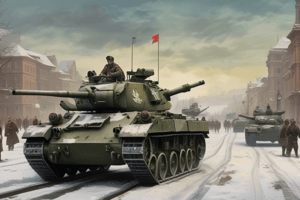Podcast
Questions and Answers
What was the main demand of the protesters in Budapest during the 1956 Hungarian Revolution?
What was the main demand of the protesters in Budapest during the 1956 Hungarian Revolution?
- Withdrawal of Soviet troops (correct)
- Multi-party elections
- Increase in permanent freedoms
- New government led by Noj Imre
Who became the new prime minister after the Hungarian Revolution?
Who became the new prime minister after the Hungarian Revolution?
- Nudge (correct)
- Noj Imre
- AVH
- The text does not provide this information
What was the West's response to the Hungarian Revolution?
What was the West's response to the Hungarian Revolution?
- They did not provide support for the rebels (correct)
- They negotiated a peace treaty between Hungary and the Soviet Union
- They provided military aid to the rebels
- They supported the Soviet Union's intervention
- The protests during the 1956 Hungarian Revolution demanded the withdrawal of __________ troops from the country
- The protests during the 1956 Hungarian Revolution demanded the withdrawal of __________ troops from the country
- The Hungarian Revolution resulted in the deaths of over 1,000 rebels and at least 500 __________ troops
- The Hungarian Revolution resulted in the deaths of over 1,000 rebels and at least 500 __________ troops
- The Hungarian Revolution demonstrated the limits of Soviet tolerance for dissent and the lengths they were willing to go to maintain __________ in their satellite states
- The Hungarian Revolution demonstrated the limits of Soviet tolerance for dissent and the lengths they were willing to go to maintain __________ in their satellite states
- The Cold War Channel is a platform that discusses the history and impact of the ______ War
- The Cold War Channel is a platform that discusses the history and impact of the ______ War
- Over 180,000 Hungarians fled the country, and those who remained were under Soviet-backed communist ______ until 1988
- Over 180,000 Hungarians fled the country, and those who remained were under Soviet-backed communist ______ until 1988
- The lynching of hundreds of members of the AVH and the Hungarian Workers Party after the ceasefire was not well-received ______
- The lynching of hundreds of members of the AVH and the Hungarian Workers Party after the ceasefire was not well-received ______
Flashcards
1956 Hungarian Revolution
1956 Hungarian Revolution
A nationwide revolt against the Soviet-backed government in Hungary, starting in October 1956.
Demands of Protesters
Demands of Protesters
Protesters in Budapest demanded withdrawal of Soviet troops and multi-party elections.
Soviet Intervention
Soviet Intervention
Soviet troops intervened on October 24th to suppress the Hungarian uprising.
Casualties of the Conflict
Casualties of the Conflict
Signup and view all the flashcards
Role of the Hungarian Army
Role of the Hungarian Army
Signup and view all the flashcards
New Prime Minister Nudge
New Prime Minister Nudge
Signup and view all the flashcards
Aftermath of Ceasefire
Aftermath of Ceasefire
Signup and view all the flashcards
Soviet Repression
Soviet Repression
Signup and view all the flashcards
Exodus of Hungarians
Exodus of Hungarians
Signup and view all the flashcards
Study Notes
The 1956 Hungarian Revolution: Protests, Violence, and Soviet Intervention
-
The liberalizing atmosphere in Hungary after Stalin's death gave hope for increased permanent freedoms, bolstered by successful reforms in Poland.
-
In October 1956, over 20,000 people gathered in Budapest demanding reforms, including the withdrawal of Soviet troops, multi-party elections, and a new government led by Noj Imre.
-
Despite the peaceful nature of the demonstrations, the Hungarian leadership condemned them and requested military assistance from the Soviet Union.
-
The protests continued to radicalize, leading to the destruction of the Stalin statue and a standoff with the secret police that resulted in violence.
-
Soviet troops entered Budapest on October 24th, and the rebels fought back, resulting in the deaths of over 1,000 rebels and at least 500 Soviet troops.
-
The Hungarian army was divided, with some units joining the protesters and others actively fighting against them.
-
Nudge became the new prime minister, and a ceasefire was arranged. The rebels were disarmed, and political parties were allowed to operate.
-
The lynching of hundreds of members of the AVH and the Hungarian Workers Party after the ceasefire was not well-received in Moscow.
-
On November 4th, Soviet forces brutally repressed the rebellion, leading to the deaths of 2,500-3,000 Hungarians and the imprisonment and execution of many more.
-
Over 180,000 Hungarians fled the country, and those who remained were under Soviet-backed communist rule until 1988.
-
The West was distracted by the Suez Crisis and did not provide support for the rebels.
-
The Hungarian Revolution demonstrated the limits of Soviet tolerance for dissent and the lengths they were willing to go to maintain control in their satellite states.Cold War Channel Support Request
-
The text is a request for financial support for the Cold War Channel.
-
The support can be provided via YouTube membership or Patreon.
-
The channel discusses the Cold War.
-
The request emphasizes that any support will be greatly appreciated.
-
The channel's name is "The Cold War Channel."
-
The text suggests that the Cold War can quickly become heated.
-
YouTube membership and Patreon are platforms for creators to receive financial support from their audience.
-
Patreon is a website where creators can receive monthly donations from their supporters.
-
The Cold War was a period of political tension between the United States and the Soviet Union.
-
The channel likely discusses the history and impact of the Cold War.
-
The request implies that the channel needs financial support to continue operating.
-
The text does not provide specific details about the channel's content or the type of support needed.
The 1956 Hungarian Revolution: Protests, Violence, and Soviet Intervention
-
The liberalizing atmosphere in Hungary after Stalin's death gave hope for increased permanent freedoms, bolstered by successful reforms in Poland.
-
In October 1956, over 20,000 people gathered in Budapest demanding reforms, including the withdrawal of Soviet troops, multi-party elections, and a new government led by Noj Imre.
-
Despite the peaceful nature of the demonstrations, the Hungarian leadership condemned them and requested military assistance from the Soviet Union.
-
The protests continued to radicalize, leading to the destruction of the Stalin statue and a standoff with the secret police that resulted in violence.
-
Soviet troops entered Budapest on October 24th, and the rebels fought back, resulting in the deaths of over 1,000 rebels and at least 500 Soviet troops.
-
The Hungarian army was divided, with some units joining the protesters and others actively fighting against them.
-
Nudge became the new prime minister, and a ceasefire was arranged. The rebels were disarmed, and political parties were allowed to operate.
-
The lynching of hundreds of members of the AVH and the Hungarian Workers Party after the ceasefire was not well-received in Moscow.
-
On November 4th, Soviet forces brutally repressed the rebellion, leading to the deaths of 2,500-3,000 Hungarians and the imprisonment and execution of many more.
-
Over 180,000 Hungarians fled the country, and those who remained were under Soviet-backed communist rule until 1988.
-
The West was distracted by the Suez Crisis and did not provide support for the rebels.
-
The Hungarian Revolution demonstrated the limits of Soviet tolerance for dissent and the lengths they were willing to go to maintain control in their satellite states.Cold War Channel Support Request
-
The text is a request for financial support for the Cold War Channel.
-
The support can be provided via YouTube membership or Patreon.
-
The channel discusses the Cold War.
-
The request emphasizes that any support will be greatly appreciated.
-
The channel's name is "The Cold War Channel."
-
The text suggests that the Cold War can quickly become heated.
-
YouTube membership and Patreon are platforms for creators to receive financial support from their audience.
-
Patreon is a website where creators can receive monthly donations from their supporters.
-
The Cold War was a period of political tension between the United States and the Soviet Union.
-
The channel likely discusses the history and impact of the Cold War.
-
The request implies that the channel needs financial support to continue operating.
-
The text does not provide specific details about the channel's content or the type of support needed.
The 1956 Hungarian Revolution: Protests, Violence, and Soviet Intervention
-
The liberalizing atmosphere in Hungary after Stalin's death gave hope for increased permanent freedoms, bolstered by successful reforms in Poland.
-
In October 1956, over 20,000 people gathered in Budapest demanding reforms, including the withdrawal of Soviet troops, multi-party elections, and a new government led by Noj Imre.
-
Despite the peaceful nature of the demonstrations, the Hungarian leadership condemned them and requested military assistance from the Soviet Union.
-
The protests continued to radicalize, leading to the destruction of the Stalin statue and a standoff with the secret police that resulted in violence.
-
Soviet troops entered Budapest on October 24th, and the rebels fought back, resulting in the deaths of over 1,000 rebels and at least 500 Soviet troops.
-
The Hungarian army was divided, with some units joining the protesters and others actively fighting against them.
-
Nudge became the new prime minister, and a ceasefire was arranged. The rebels were disarmed, and political parties were allowed to operate.
-
The lynching of hundreds of members of the AVH and the Hungarian Workers Party after the ceasefire was not well-received in Moscow.
-
On November 4th, Soviet forces brutally repressed the rebellion, leading to the deaths of 2,500-3,000 Hungarians and the imprisonment and execution of many more.
-
Over 180,000 Hungarians fled the country, and those who remained were under Soviet-backed communist rule until 1988.
-
The West was distracted by the Suez Crisis and did not provide support for the rebels.
-
The Hungarian Revolution demonstrated the limits of Soviet tolerance for dissent and the lengths they were willing to go to maintain control in their satellite states.Cold War Channel Support Request
-
The text is a request for financial support for the Cold War Channel.
-
The support can be provided via YouTube membership or Patreon.
-
The channel discusses the Cold War.
-
The request emphasizes that any support will be greatly appreciated.
-
The channel's name is "The Cold War Channel."
-
The text suggests that the Cold War can quickly become heated.
-
YouTube membership and Patreon are platforms for creators to receive financial support from their audience.
-
Patreon is a website where creators can receive monthly donations from their supporters.
-
The Cold War was a period of political tension between the United States and the Soviet Union.
-
The channel likely discusses the history and impact of the Cold War.
-
The request implies that the channel needs financial support to continue operating.
-
The text does not provide specific details about the channel's content or the type of support needed.
Studying That Suits You
Use AI to generate personalized quizzes and flashcards to suit your learning preferences.





